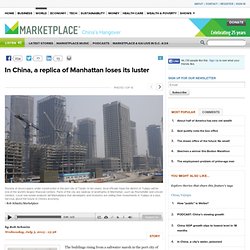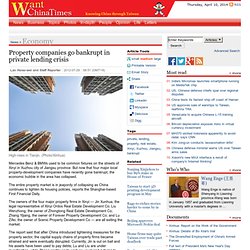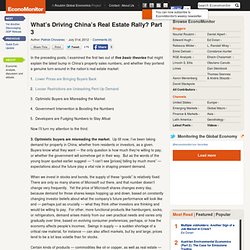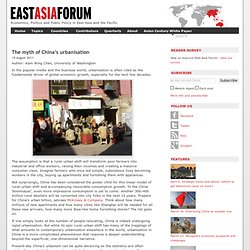

In China, a replica of Manhattan loses its luster. The buildings rising from a saltwater marsh in the port city of Tianjin looks an awful lot like New York City.

But don’t be fooled, says Lin Lixue, a dapper young spokesman for a local developer. This Manhattan replica aims to be a bigger Apple. “Our goal is to create the world’s largest financial center, right here, within ten years," says Lin. "We’re building skyscrapers, we’ve got China’s largest high-speed railway station coming soon, we’re building a tunnel under the sea, and we’ll soon build several subway lines.”
Li sounds like a boy whimsically building sandcastles. Zhang Xiaoying is a real estate analyst for Tianjin Centaline Property Consulting. "Don’t invest here! " The way Zhang sees it, Yujiapu is more Detroit than Manhattan, and it hasn’t even been built yet. "Hu Jintao," Zhang says with a nervous giggle. Ghost Cities - China.
Property companies go bankrupt in private lending crisis|Economy. High-rises in Tianjin.

(Photo/Xinhua) Mercedes Benz & BMWs used to be common fixtures on the streets of Xinyi in Xuzhou city of Jiangsu province. But now that four major local property-development companies have recently gone bankrupt, the economic bubble in the area has collapsed. The entire property market is in jeapordy of collapsing as China continues to tighten its housing policies, reports the Shanghai-based First Financial Daily.
China’s Ghost Cities. The following video is the first of the great series on China’s ghost cities that Bloomberg is running this week.

Getting China right is key to your P&L and the direction of many markets, including emerging equities and commodities. We’re grappling with who financed these cities, who is holding the paper, and how were they financed. Recall China’s massive money supply growth and credit expansion which funded the country’s stimulus after the 2007-8 financial collapse. Our basic assumptions may be wrong, such as time horizon and holding period, and Adam Johnson does a good job covering these, but this is one issue that keeps us up at night and we won’t rest until we’re comfortable with a good working understanding of what is going “over there.” The renowned hedge fund manager, Jim Chanos, has and we suggest you do the same. Our good friend Deano Williams reminds us of the cheerleading mantra of the real estate industry , “they ain’t building anymore real estate.” Category: Think Tank. GMO: Something's Fishy in China. GMO: Something's Fishy in China By Robert Huebscher January 17, 2012 A wide gulf separates the two most prominent views regarding China’s future.

Faced with slowing economic growth, one side says its leaders will deftly navigate a soft landing, while the other claims it will face an implosion similar to those that befell Japan 20 years ago and the US in 2008. Count GMO, a firm that has built its reputation on its ability to identify a bubble about to pop, in the latter camp. Edward Chancellor, who focuses on capital market research as a member of Grantham, Mayo, Van Otterloo’s asset allocation team, laid out that negative forecast last week when he spoke in London at a research symposium hosted by Societe Generale.
Accusing the soft-landing camp of “uncritically accepting” China’s growth story and placing an “overblown belief” in the authorities in Beijing, Chancellor listed 10 tell-tale traits of an economy on the verge of collapse. What’s Driving China’s Real Estate Rally? Part 1. The buzz is that China real estate is back.

After nearly a year of steep discounting, with both land and housing sales in April looking like they were falling of a cliff, the market was electrified in late May by stories of would-be home-buyers lining up around the block and entire luxury developments selling out on the days sales opened. China Securities Journal reported that Beijing housing sales were up 46.5% YoY in May, Xinhua reported they were up 50.6% YoY in June, and property agency Centaline says they’ve continue to surge at 37% YoY in the first half of July. Over Dragon Boat Festival weekend, in late June, China’s Housing Ministry said sales volume for Beijing residential property soared 289% YoY (nearly 4x), and Centaline said six other cities saw sales growth greater than 100% YoY that same weekend.
In Shanghai, housing sales surge 65% WoW in late June and, according to China Business News, primary market sales that month rebounded close to their five-year average. 1. What’s Driving China’s Real Estate Rally? Part 2. Yesterday, I began an investigation into the potential causes behind the latest bump in China’s property sales numbers, and whether they portend a genuine turn-around in the nation’s real estate market.

I noted that five basic theories to account for what has been happening, and promised to examine them each in turn: Lower Prices are Bringing Buyers BackLooser Restrictions are Unleashing Pent-Up DemandOptimistic Buyers are Misreading the MarketGovernment Intervention is Boosting the NumbersDevelopers are Fudging Numbers to Stay Afloat In my last post, I concluded that it was certainly possible that a fall in both real and nominal property prices could explain a recovery in sales, as properties become more affordable to buyers.
However, this theory cannot explain the rebound in property prices reportedly taking place, nor should it offer much comfort to hard-pressed developers, who would may have to endure steep losses to clear their inventories at reduced prices. 2. What’s Driving China’s Real Estate Rally? Part 3. In the preceding posts, I examined the first two out of five basic theories that might explain the latest bump in China’s property sales numbers, and whether they portend a genuine turn-around in the nation’s real estate market: Lower Prices are Bringing Buyers BackLooser Restrictions are Unleashing Pent-Up DemandOptimistic Buyers are Misreading the MarketGovernment Intervention is Boosting the NumbersDevelopers are Fudging Numbers to Stay Afloat Now I’ll turn my attention to the third: 3.

China’s housing bubble: New evidence. For a while now, analysts have been arguing there is a bubble in China’s property market. Using records from 35 major cities this column finds evidence of a housing bubble. It compares house prices to cointegrated fundamentals and finds that property in China is in general overvalued by around 20% – and even more so in the boom towns. For many observers, the Chinese economy has been spurred by a bubble in the real-estate market, probably driven by the fiscal stimulus package and massive credit expansion (Nicolas 2009). For example, the stock of loans increased by more than 50% since the end of 2008. In reaction to the global crisis, the government urged banks to increase lending (Cova et al. 2010). There are several indications that the market might have overheated in recent years. To dampen the evolution, the People’s Bank of China has increased its nominal interest rate. A burst of a house-price bubble can be harmful for the real economy.
Figure 1. The myth of China’s urbanisation. Author: Kam Wing Chan, University of Washington In the popular media and the business world, urbanisation is often cited as the fundamental driver of global economic growth, especially for the next few decades.

The assumption is that a rural–urban shift will transform poor farmers into industrial and office workers, raising their incomes and creating a massive consumer class. Imagine farmers who once led simple, subsistence lives becoming workers in the city, buying up apartments and furnishing them with appliances. Not surprisingly, China has been considered the poster child for this linear model of rural–urban shift and accompanying inexorable consumption growth. To the China ‘boomsayer’, even more impressive consumption is yet to come: another 300–400 million rural dwellers will be converted into city folks in the next 15 years. If one simply looks at the number of people relocating, China is indeed undergoing rapid urbanisation.